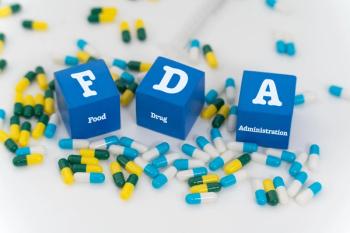
- Drug Topics June 2020
- Volume 164
- Issue 6
Barhemsys (Amisulpride) for Postoperative Nausea and Vomiting
On February 27, 2020, the FDA approved an intravenous solution of amisulpride (Barhemsys; Acacia Pharma) to treat and prevent postoperative nausea and vomiting.
On February 27, 2020, the FDA approved an intravenous solution of amisulpride (Barhemsys; Acacia Pharma) to treat and prevent postoperative nausea and vomiting (PONV). For prevention, amisulpride can be used alone or with another antiemetic. For PONV treatment, it may be administered to patients who received no prophylactic therapy or received a different drug during prophylaxis. Amisulpride, a selective D2/D3 dopamine receptor antagonist, is the first of Acacia Pharma’s pipeline medications to be approved after showing positive results in 4 phase 3 clinical trials.
EFFICACY
Data from 4 randomized double-blind, placebo-controlled, multicenter trials supported the approval of amisulpride for prevention and treatment of PONV.
Two studies evaluated the agent’s use for prevention of PONV in patients undergoing general anesthesia and elective surgery. In both studies, treatment groups were matched for PONV risk factors. In study 1, participants (n = 342) received 5 mg of amisulpride (n = 176) or placebo (n = 166). In study 2, participants (n = 1147) received amisulpride plus standard therapy of ondansetron, betamethasone, or dexamethasone (n = 572) or placebo plus a standard antiemetic (n = 575). The primary outcome in both studies was complete response (CR), defined as no emesis and no use of rescue medication in the 24-hour postoperative period. In both studies, groups receiving amisulpride demonstrated increased rates of CR: study 1, 44% in the amisulpride treatment group vs 33% in the placebo group (difference, 12%; 95% CI, 2%-22%); study 2, 58% in the amisulpride plus standard antiemetic group vs 47% in the placebo plus standard antiemetic group (difference, 11%; 95% CI, 5%-17%).
Amisulpride’s effectiveness for treating PONV was demonstrated in 2 studies using the agent as a 10-mg single dose. In study 3
(n = 369), participants did not receive prior prophylaxis. Participants in study 4 (n = 465) received prior prophylaxis therapy with a nondopaminergic antiemetic (77%, 5-HT3 receptor antagonist; 65%, dexamethasone; 10%, other medication). Both studies evaluated the CR rates within 24 hours after administration with amisulpride excluding emesis within the first 30 minutes. Groups receiving amisulpride demonstrated increased rates of CR: study 3, 31% in the amisulpride treatment group vs 22% in the placebo group (difference, 10%; 95% CI, 1%-19%); study 4, 42% in the amisulpride treatment group vs 29% in the placebo group (difference, 13%; 95% CI, 5%-22%).
Overall, participants given amisulpride experienced significantly lower incidence of emesis, nausea, and rescue medication use compared with placebo, as monotherapy, and combined with other antiemetics.
SAFETY
Among all the studies of amisulpride, the adverse event (AE) profile was similar to that of the placebo groups. The most common AEs include infusion-site pain (6%), increased serum prolactin (5%), hypokalemia (4%), chills (4%), procedural hypotension (3%), and abdominal distention (2%). QT prolongation is a dose- and concentration-dependent AE associated with amisulpride use. It is unlikely to contribute to a meaningful QT prolongation at approved doses, but monitoring is recommended in patients who are at higher risk; have preexisting arrhythmia or cardiac conduction disorders, congestive heart failure, hypokalemia, hypomagnesemia; or receive concurrent medications that can prolong the QT interval (such as ondansetron). Amisulpride is extensively renally eliminated; its use should be avoided in patients who have severe renal dysfunction, with an estimated glomerular filtration rate less than 30 mL/min/1.73m2, because these patients may be at increased risk of AEs.
DOSING
For prevention of PONV, amisulpride is given as a 5-mg, single-dose infusion over 1 to 2 minutes at the induction of anesthesia. This may be administered as monotherapy
or with another antiemetic medication. For treatment of PONV, amisulpride is infused as a 10-mg dose over 1 to 2 minutes in the event of nausea or vomiting after surgery.
Reference
Barhemsys. Acacia Pharma; 2020. Accessed May 19, 2020. https://www.accessdata.fda.gov/drugsatfda_docs/ label/2020/209510s000lbl.pdf
Articles in this issue
over 5 years ago
Adapt to a “New Normal” During Uncertain Timesover 5 years ago
No Good Deed Goes Unpunishedover 5 years ago
Pharmacies Can Take Steps to Protect Against Cyberattacksover 5 years ago
Offer Patients OTC Pointersover 5 years ago
Keep Current on Vaccines to Reassure Hesitant Patientsover 5 years ago
Get Educated on Diabetes Devicesover 5 years ago
Pharmacists Fight HIVover 5 years ago
Integrative Medicine Presents Opportunities, Poses ChallengesNewsletter
Pharmacy practice is always changing. Stay ahead of the curve with the Drug Topics newsletter and get the latest drug information, industry trends, and patient care tips.











































































































































































































